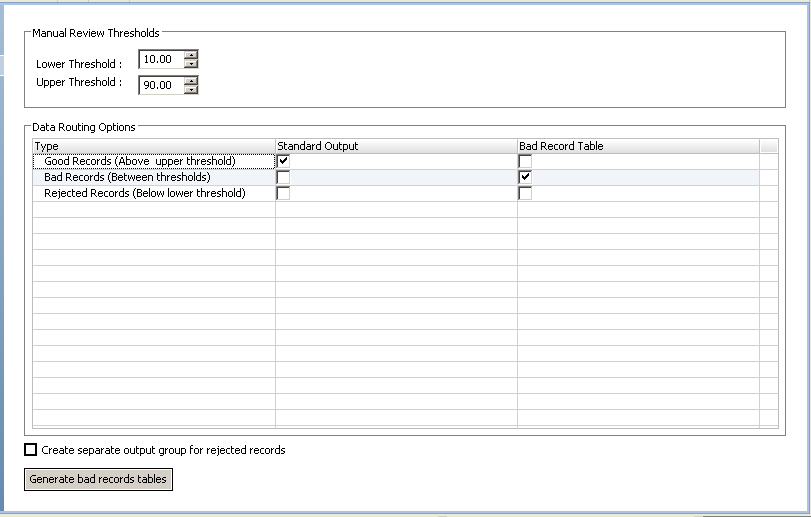Bad Record Exception Configuration View
The Configuration view specifies the upper and lower thresholds that the transformation uses to identify good records and bad records. The Configuration view also identifies the target tables for the records with scores that are above or below the thresholds.
The following figure shows the Exception transformation Configuration view:
You can configure the following properties in the Configuration view:
- Lower Threshold
- The lower limit for the bad record score range. The transformation identifies records with scores that are below the lower threshold as rejected records.
- Upper Threshold
- The upper limit for the bad record score range. The transformation identifies records with scores that are greater than or equal to the upper threshold as good records.
- Data Routing Options
- The types of output records. In the default configuration, the transformation writes good records to the Standard Output and writes bad records to the Bad Records table. By default, the transformation does not write the rejected records to a database table.
- Standard Output
- The types of record that the transformation writes to the standard output ports. Default is Good Records.
- Bad Record Table
- The types of record that the transformation writes to the bad record output ports. Default is Bad Records.
- Create separate output group for rejected records
- Creates a separate output group for the rejected records. The option is clear by default.
- Generate bad records table
- Creates a database table to contain the bad record data. When you select the option, the Exception transformation creates the database table, adds a data object to the Model repository, and adds an instance of the object to the mapping canvas. You can generate the bad records table for an Exception transformation instance in a mapping. When you generate the bad records table, the Developer tool also creates an issues table to store descriptive metadata about the records.
Note: The Developer tool adds a 12-character suffix to each column name in the bad record tables. If you use an Oracle database, the source column name can contain no more than 18 characters.
Generating the Bad Records Table and the Issues Table
When you add the transformation to a mapping, you can generate the Bad Records table and the Issues table. The Developer tool adds the tables to the Model repository.
1. Click Generate bad records table to generate the table.
The Create Relational Data Object dialog box appears.
2. Browse the database connections. Select a connection to the database to contain the table.
3. Enter a name for the Bad Records table. The Developer tool applies the name that you enter to the Bad Records table and to the Issues table.
The Developer tool appends the following string to the Issues table name:
_ISSUE
If you connect to an Oracle database, the Bad Records table name must contain no more than 24 characters.
4. Enter a name for the Bad Records data object in the Model repository.
5. Click Finish.
The Developer tool adds the tables to the mapping canvas and to the Model repository.

